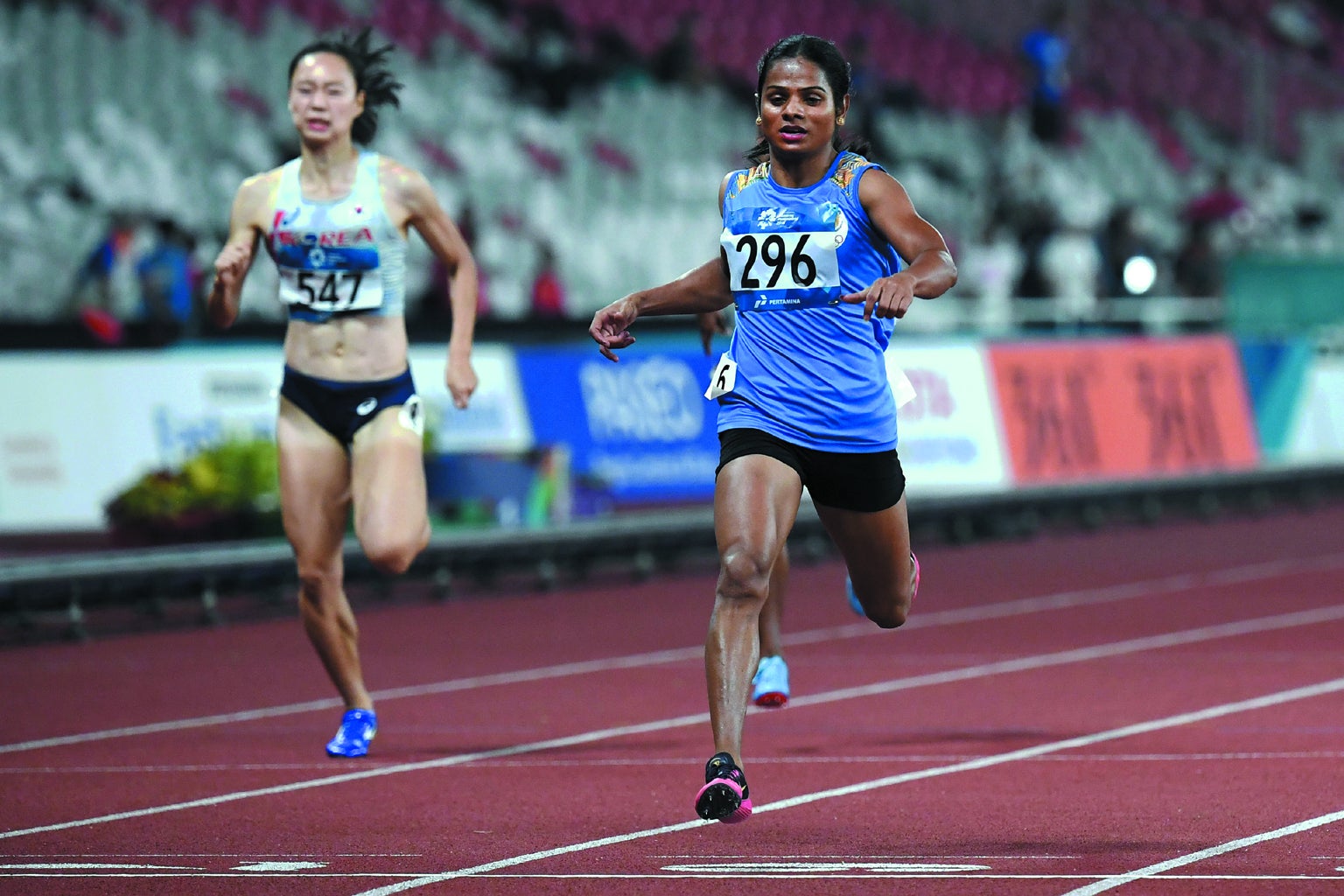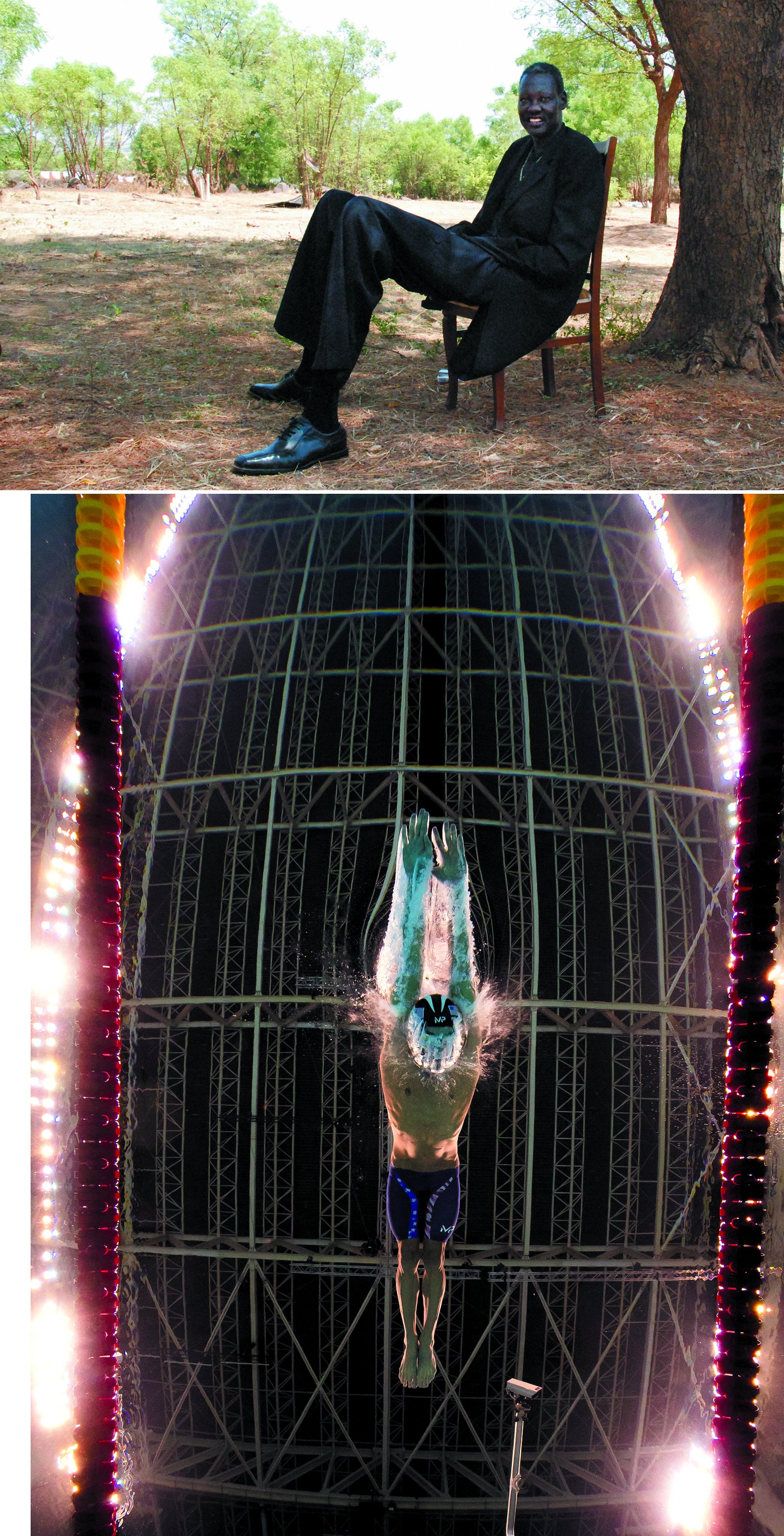In February 2016 Dutee Chand became the best woman sprinter in India. The record she set on an indoor track in Qatar during a qualifying heat stands as the fastest time an Indian woman has ever achieved in the 60-meter race, and she soon became the first Indian woman in decades to race the 100 meters at the Olympics. Just a year earlier, however, Chand had faced the possibility of never again running competitively.
In 2014, as Chand was making her mark on the junior-level track world, the Athletics Federation of India (AFI), with the support of its international parent body World Athletics, barred her from competing in women's events because of atypically high levels of testosterone occurring naturally in her body. (There is no evidence Chand ever took banned substances to alter her hormones.) According to the AFI, which runs India's track-and-field competitions, her higher-than-average testosterone level gave her physical advantages enjoyed by male athletes. Chand disputed the idea that this hyperandrogenism—an elevated level of androgens, the class of hormones that includes testosterone—made her more like a male sprinter than a female one, and in 2015 the Court of Arbitration for Sport agreed with her. It determined that World Athletics, which sets the rules governing international track-and-field competitions, had not presented enough scientific evidence to defend its claims—and Chand could run again.
But World Athletics now contends that it has found an adequate scientific basis for barring women with high testosterone from competing in races between 400 meters and one mile unless they take medication to lower their testosterone levels or opt to compete against men. This policy does not apply to Chand, because she runs shorter distances, but it could end the athletic dreams of Mokgadi Caster Semenya, an Olympic gold medalist and a hero in her home country of South Africa. In 2019 the Court of Arbitration for Sport accepted World Athletics' argument, and the Swiss Supreme Court upheld this decision in September 2020. Rather than undergo medically unnecessary treatment to suppress her testosterone levels, Semenya has decided to compete only in the 200-meter race, an event without limits on testosterone levels, at the 2021 Tokyo Olympics.
This sequence of controversial decisions has prompted a public debate about fairness and discrimination in sports. Throughout the Olympics' modern history, rules about who counts as a woman have shifted as the scientific understanding of sex has progressed. Disqualifying athletes on the basis of natural testosterone levels is one of the last legal forms of discrimination in sports.
As an interdisciplinary scholar trained in both biology and gender studies, I have examined the ways in which scientists take social categories such as “woman” and “man” and attempt to turn them into fundamental truths. For as long as scientists have been trying to figure out the biological basis of sex and gender, nature has presented divergences from their theories. (“Sex” refers to biological characteristics; “gender” refers to social roles and identification.)
Most men have XY chromosomes and developed testicles in utero that, later in life, secrete relatively high amounts of testosterone into their bloodstreams. In contrast, most women have XX chromosomes, which drives the production of ovaries and lower levels of testosterone. Some women, however, have XY chromosomes as well as external female anatomy; these women are affected by the World Athletics policy. Such attributes reflecting variation beyond the rigid male/female binary are known as intersex traits.
According to interAct, an intersex advocacy organization, 1.7 percent of the population may be intersex, although many never realize it. And they may be overrepresented in the world of elite sports: in its published decision, the Court of Arbitration for Sport repeatedly referenced the statistic that among elite athletes, women with XY chromosomes are far more common than they are in the general population.
It seems, then, that intersex women may have an edge in athletic competitions. But so, too, do athletes with natural advantages such as, say, height in basketball tournaments. The important question here is not whether some sex traits can confer athletic advantages but whether those advantages are so meaningful and so incontrovertible that they should prevent a woman athlete such as Semenya from competing against other women.
Chromosomes and Hormones
Sex has never been a simple binary. Nevertheless, Olympic regulators have tried for decades to apply overly simplistic rules to this messy reality. From the 1960s until the 1990s dozens of women were singled out and even disqualified because of their chromosomes. The first was Ewa Kłobukowska, who was deemed a woman based on genital examination in 1966 but was disqualified from the 1968 Olympics because of her XY chromosomal makeup. Kłobukowska's story is not so surprising: Some intersex women are anatomically so similar to other women that they never discover their XY chromosomal makeup.

Chromosomal testing thus disqualified some people who had every trait of the female sex except for XX chromosomes. This contradiction, coupled with the invasiveness of some testing and the dire social consequences for those who failed the tests, eventually led the International Olympic Committee to abandon sex testing in the 1990s. But its concern about ensuring the apparent fairness of women's competitions did not disappear, and it reserved for itself the option to test people on a case-by-case basis. Recent cases of sex testing have focused not on chromosomes but on an aspect of sex ostensibly more related to athletic ability: testosterone levels.
Athletes have been using artificial testosterone since at least the 1950s in the hopes of improving their performance, but until the 1990s the medical community did not hold that the link between supplemental testosterone and athletic ability had adequate scientific support. That might have influenced the International Olympic Committee's choice not to use testosterone levels in its sex-verification era. The paradigm changed after 1996, when a study demonstrated that testosterone supplementation, in combination with weight training, could increase both muscle size and strength in men.
Since then, endocrinologists have greatly expanded their understanding of the relation between testosterone and muscle mass. The evidence shows that testosterone both increases the number of muscle cells that the body produces and enhances muscle size. There is some evidence that testosterone may also influence athletic ability through other mechanisms. In one experiment, men who took high levels of testosterone (but not those who took lower levels) had increased levels of hemoglobin in their bloodstreams, a change that allows blood to carry more oxygen to the rest of the body. Testosterone could also exert influence on bone mass because low testosterone levels, much like low estrogen levels, are correlated with osteoporosis, and both hormones have a role in maintaining bone structure.
In fact, androgens (“male” hormones, including testosterone) and estrogens (“female” hormones) are much more tightly linked than most people imagine. For starters, everyone naturally produces both hormones. And all naturally occurring estrogen in humans was once testosterone, transformed into estrogen by the enzyme aromatase. Scientists debate how much of a given hormone is “normal” and how those levels should be measured—one recent study even concluded that “normal” testosterone levels for women should be adjusted to better accommodate female athletes. And men's and women's estrogen levels can actually overlap, especially during some phases of the menstrual cycle. Even so, testosterone levels do vary considerably between men and women: younger men's levels tend to range between 10 and 40 nanomoles per liter of blood, whereas women's levels tend to range between 0.5 and 3 nmol/L.
Taken together, the available evidence—the gap in between most men's and women's testosterone levels, the established connection between testosterone doping and increased muscle mass, and the approximately 10 percent advantage that elite men have over elite women in track events—seems to imply that women with high testosterone levels will run like men. Nevertheless in Chand's case, the Court of Arbitration for Sport found that she could not be banned from competition, because there was not yet any direct evidence of the relation between natural testosterone levels and athletic ability in elite women.
The court decided differently in Semenya's case four years later, partly because it believed that such evidence had been produced. Stéphane Bermon, head of World Athletics' scientific team, had recently published a paper that analyzed data from two international athletics competitions and found that women with higher levels of testosterone performed better, on average, than women with lower levels. Because this study is based on real-world data from elite female runners, it arguably represents the most relevant findings in the hyperandrogenism controversy to date.
I spend some of my research time trawling the scientific literature to find cases of researchers making statistical errors, particularly when their studies pertain to marginalized groups. So I was intrigued to read that a group of scientists had questioned the validity of this key study on the basis of issues with the data. In response to their concerns, Bermon updated the study, and although he still observed some effects, his conclusion was markedly weakened by the correction. When I performed a procedure called correcting for multiple comparisons—a statistical method that takes into account the increased probability of finding at least one false positive when many statistical tests, as opposed to only one, are conducted—on his reported results, these effects disappeared.
This complication does not imply that there is no relation between testosterone and athletic performance in women. What is certainly the case, however, is that far more research is needed before a firm conclusion can be reached.
Supplemental is not Natural
If testosterone taken illegally and testosterone produced naturally had the same impact on all bodies, one would assume that male-typical levels of testosterone necessarily confer a male-typical athletic advantage. But to understand what such studies mean for women like Semenya, we must understand how their bodies work. All the women targeted by World Athletics' policy on testosterone levels are intersex, with a similar set of sex traits: they have XY chromosomes, but their bodies do not respond to androgens in the same way most XY individuals do. Because of the complexity inherent in the function of hormones, it is extremely difficult to determine the precise effect that testosterone will have on these intersex people.
Even if androgens did have a completely typical effect on them, the link between testosterone and athletic ability would remain far more tenuous than it might seem. Taking supplemental testosterone may tend to give someone bigger muscles, but that does not automatically imply that a person with naturally higher testosterone levels will be better at sports than someone with lower testosterone levels. Even the original, contested version of Bermon's study hints at a nuanced connection: whereas testosterone showed a positive effect on athletic ability for a couple of events, no effect was observed for 16 other events, and the data suggested that higher testosterone levels may be associated with worse performance in several events.
One study of elite Swedish athletes found no association between testosterone and athletic performance, and a recent study of teenage athletes in Australia showed a strong negative correlation between testosterone levels in women and performance. Men, too, do not necessarily gain an enormous advantage from high testosterone levels: almost 17 percent of elite male athletes measured in one study had testosterone levels below the typical male range, and nearly 10 percent of them had testosterone levels under 5 nmol/L.

The clear effect of testosterone supplements on the body and the average differences in muscle mass between men and women make it easy to assume that higher testosterone levels automatically confer superior athletic ability regardless of other factors. But the science shows that, at least among elite athletes, the link between testosterone and athletic performance is far from straightforward.
One of the first things a person learns when studying the science of sex and gender is how difficult it is to disentangle biological and social influences. For me, this issue came into stark relief when I studied apparently sex-linked advantages in areas such as spatial ability. Because men tend to experience both higher levels of testosterone and more encouragement in STEM fields than do their female counterparts, it is difficult to determine whether biological or social factors cause these differences. To answer these questions, scientists study people who have high testosterone and do not experience a masculine social environment—that is, women with particular intersex traits—and examine their behavior to differentiate between biological and social causes.
The story gets far more convoluted when we try not only to distinguish between biological and social causes but also to investigate how those factors interact. One fascinating example comes from the work of neuroscientist Melissa Hines, who studied girls with congenital adrenal hyperplasia, a condition in which intersex traits arise in XX females because of unusually high levels of androgens. Hines showed that these girls tend to engage in play behavior seen relatively more often in boys, such as horseplay. More recently, however, she demonstrated that the girls do not necessarily prefer horseplay over dolls: they just do not care about what other girls tend to do. Most young girls will prefer to play with a red ball over a blue ball if they see that other girls are playing only with red balls, but girls with congenital adrenal hyperplasia will happily play with either toy. Testosterone does not make girls more likely to wrestle than to read; it simply changes the extent to which they respond to social cues about gender.
In terms of its effects on behavior, testosterone is thus quite complex: it seems to work together with social cues such that neither factor can be isolated from the other. Although these apparently psychological observations may be irrelevant to the question of athletic ability, even Bermon and his colleagues have suggested that dominance and aggression, long associated with testosterone levels, could have a role in winning races. In one of the only studies that systematically examined the effect of taking testosterone on women's physical ability, those who took high levels of the hormone saw modestly increased muscle mass and dramatically increased strength. The researchers hypothesized that some unmeasured psychological factor allowed their slightly more developed muscles to make extraordinary athletic gains.
But it is also far too simplistic to assume that testosterone causes aggression or competitiveness, even though women might be more likely to enter competitive situations when their testosterone levels are higher, and men who respond more strongly to androgens might be more confident about their chances in competition. In fact, numerous studies have demonstrated that a person's testosterone levels will increase after, rather than before, they have won a competition or otherwise shown dominance, and one 2015 study suggested that this effect might be stronger in women than it is in men. Behavior, which is affected by social norms about men and women, exerts an influence on hormone levels—demonstrating yet again the intricate and perhaps inextricable links between the social and the biological.
When critics argue that intersex women are basically “biological men” who just happen to have clitorises and labia, they are completely neglecting the enormous influences that the categories “men” and “women” have on all of our lives—and on all of our bodies. Testosterone is not some mysterious entity that comes from nowhere to exert a huge influence on our bodies and our minds: it both changes and is changed by gender norms.
Despite being just a single element in a knotty, sometimes circular network of factors that contribute to athletic ability, testosterone is unlikely to be completely irrelevant. Somehow XY women seem likelier to achieve physical feats than XX women. This observation does not imply, however, that intersex women should be forced to compete in the men's category against men, against whom they will surely lose. Arguing that biology instructs us to divide athletes at a threshold of five nanomoles of testosterone per liter of blood, as World Athletics has done, implies that this threshold splits humans into the two fairest, most equal competitive groups possible.
Given that testosterone affects athletic ability in a complex, nonlinear fashion, this suggestion is not supported by the evidence. It would be far more sensible to split basketball into two separate height divisions: no current player in the NBA is shorter than 5'9”, whereas both low-testosterone men and low-testosterone women can be extremely successful athletes. Nor is there any cogent reason to identify intersex conditions as conferring unique genetic advantages in a domain such as elite athletics, where a variety of unusual traits lead to success. Why should swimmer Michael Phelps's low lactic acid production (which helps stave off muscle fatigue) or the late NBA player Manute Bol's uncommon height be rewarded while Semenya's somewhat higher testosterone level is disqualifying?
If biology cannot give us a firm basis for dividing athletes into two distinct categories, we might wonder why we have men's and women's divisions at all. Although testosterone levels might not divide all of humanity neatly into better and worse athletes, it is the case that, at the most elite level, men outperform women in sports such as track. Making sports coed and thus de facto barring women from Olympic races would not be intrinsically unfair—after all, plenty of groups of people, such as those with poor cardiovascular health, can never dream of becoming elite runners—but it would be regrettable. We would lose women such as sprinter Allyson Felix, swimmer Katie Ledecky and the extraordinary U.S. women's soccer squad, all of whom inspire countless young women.
Biology alone is too limited a tool to tell us how to divide up the athletic field—but it can help us gain a greater understanding of natural human variation. Particularly in a domain as convoluted and controversial as sex and gender, science often uncovers more ambiguity than it resolves. And if science does not inform the issue of intersex women in sports, we can still revert to the values of diversity, inclusion and acceptance that make elite women's sports so extraordinary in the first place.



